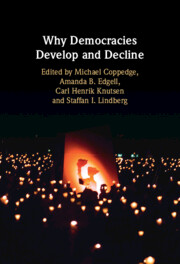Book contents
- Why Democracies Develop and Decline
- Why Democracies Develop and Decline
- Copyright page
- Contents
- Figures
- Tables
- Tables in Appendices
- Acknowledgements
- 1 V-Dem Reconsiders Democratization
- 2 The Ups and Downs of Democracy, 1789–2018
- 3 Long-Run Factors
- 4 International Influence
- 5 Economic Determinants
- 6 Political Institutions and Democracy
- 7 Democracy and Social Forces
- 8 Causal Sequences in Long-Term Democratic Development and Decline
- Appendices
- Bibliography
7 - Democracy and Social Forces
Published online by Cambridge University Press: 28 June 2022
- Why Democracies Develop and Decline
- Why Democracies Develop and Decline
- Copyright page
- Contents
- Figures
- Tables
- Tables in Appendices
- Acknowledgements
- 1 V-Dem Reconsiders Democratization
- 2 The Ups and Downs of Democracy, 1789–2018
- 3 Long-Run Factors
- 4 International Influence
- 5 Economic Determinants
- 6 Political Institutions and Democracy
- 7 Democracy and Social Forces
- 8 Causal Sequences in Long-Term Democratic Development and Decline
- Appendices
- Bibliography
Summary
New social forces that emerge as part of the process of development turn structural change into political change. Their struggles for representation and incorporation occupy a prominent place in our understanding of regime change. Even elite-driven democratic transitions necessitate moments of mass mobilization that push liberalization into regime change. Many scholars also contend that an active citizenry leads to democratic stability via more effective government. In contrast, others warn that a mobilized and polarized civil society can undermine democracy – particularly if the demands of social forces outstrip the capacity of institutions to process them. In this chapter, we explore the effects of social organization and mobilization on democracy. Using the Varieties of Democracy (V-Dem) and Nonviolent and Violent Campaigns and Outcomes (NAVCO) data, we gauge the extent to which organized and mobilized social forces are responsible for levels and changes in democracy. We find that civil society participation and nonviolent protest positively affect democracy and that rightwing anti-system movements constitute the largest threat to democracy.
- Type
- Chapter
- Information
- Why Democracies Develop and Decline , pp. 185 - 214Publisher: Cambridge University PressPrint publication year: 2022
- 4
- Cited by

